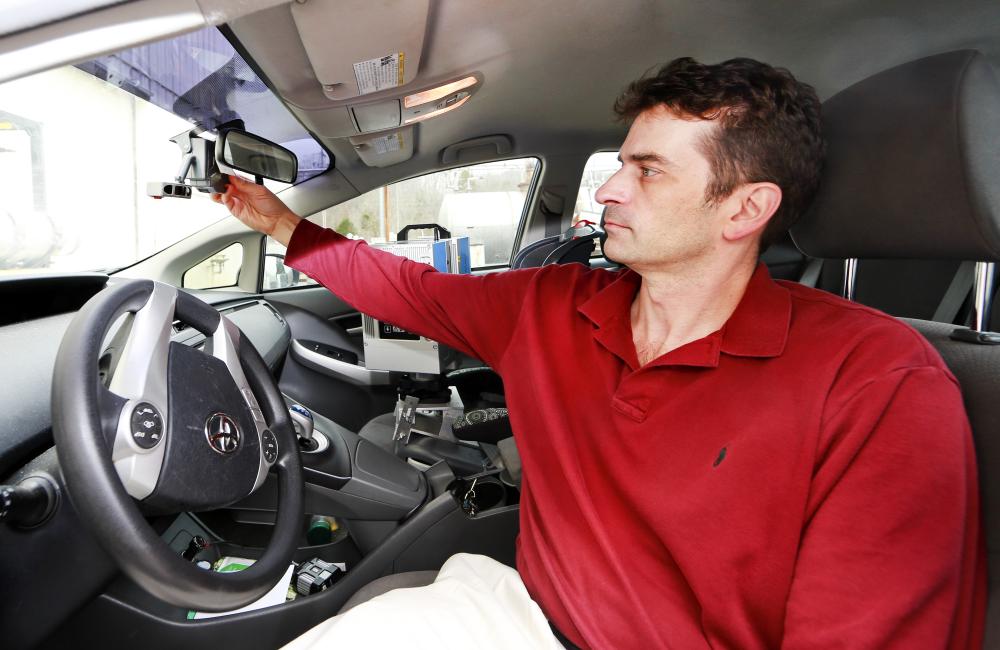Tom Karnowski positions a naturalistic driving study camera unit in 2013. Credit: Jason Richards/ORNL, U.S. Dept. of Energy
What really causes car crashes and what can be done about them? Researchers at the Department of Energy’s Oak Ridge National Laboratory are applying expertise in using computers to process images using machine learning to improve studies of how driver behavior and environmental factors lead to crashes.
“We don't really know why automobile crashes occur,” said Tom Karnowski, leader of ORNL’s Cyber Sensing and Analytics group. “Police, drivers or witnesses might have a really good guess, but they may have biases that influence what they think they saw.”
Karnowski’s team works with the Federal Highway Administration to create usable data sets and tools from a massive collection of videos called the Strategic Highway Research Program, commonly known as SHRP2, and test algorithms for analyzing the data. The U.S. government is seeking better ways to understand what happens in the few seconds before or after a crash as well as in dangerous activities that do not result in a crash.
SHRP2 was a two-year program that used cameras and sensors to record inside and outside a vehicle during a drive. Cameras faced the driver, the driver’s hands and inside the vehicle while additional sensors positioned around the car recorded objects and weather conditions.
Though SHRP2 no longer collects data, the videos themselves remain a valuable trove of information. Transportation researchers use this data to improve roadway safety and mobility by exploring not only crashes but other hazardous driving activities as well. Data sets and tools put together by Karnowski’s team can be queried with specific questions, such as how effective rumble strips are or how close is too close to follow another car.
“The crashes themselves are obviously important, but there's a lot more data there than just the crashes.”
Simple machine learning algorithms flag a video file when a crash occurred. More complex computer vision algorithms, though, can be designed to detect body movement, such as how a person displays signs of distraction. Even if no crash occurred, the advanced algorithms still register the driver as distracted and flag the video for review. Transportation researchers get a more complete set of distracted driver videos to review — regardless of whether a crash occurred — to understand the context around potentially dangerous situations.
“The crashes themselves are obviously important, but there's a lot more data there than just the crashes,” said Karnowski, who has taken on two primary missions with his computer vision algorithms: finding events that don't have an abrupt motion component and making the data more useful.
While the SHRP2 research looks at driving as an activity, regardless of the vehicle being driven, auto companies are adding their own sensors and collecting information about the driver, the car, and the surrounding area for their proprietary research. What can’t be discerned from SHRP2 is how newer safety features affect how a driver drives. But Karnowski posits there are driving behaviors that won’t change no matter how technology evolves, at least until cars are fully automated.
With those fundamental behaviors in mind, ORNL researchers have helped improve the quality and accessibility of the SHRP2 data. The team’s computer vision algorithms have helped overcome the drawbacks of compressed, low-resolution video from outdated collection systems, for example. And ORNL researchers with expertise in facial recognition software and identity sciences have collaborated with the University of Texas-Dallas to test methods that protect driver faces without hiding relevant details of their activities, thereby reducing privacy concerns and allowing broader sharing of the data.
Karnowski’s team recently received additional funding from the Federal Highway Administration to evaluate new tools written by others using SHRP2 data and investigate new areas of transportation research. Having an external assessment helps researchers get the best tools when they interact with the data. In the future, Karnowski is looking to continue exploring the applications of artificial intelligence in transportation particularly for smart cities.
Though Karnowski has been studying natural driving habits for about a decade, he is honest about how this increased knowledge of crashes impacts his own driving. “We have to remember: Life is too precious to waste on a phone call or text message.”
UT-Battelle manages ORNL for the Department of Energy’s Office of Science, the single largest supporter of basic research in the physical sciences in the United States. The Office of Science is working to address some of the most pressing challenges of our time. For more information, please visit energy.gov/science. — Liz Neunsinger



